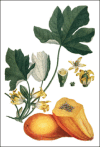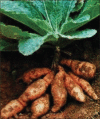Medicinal plants and their effects on diabetic wound healing
- PMID: 31327900
- PMCID: PMC6584855
- DOI: 10.14202/vetworld.2019.653-663
Medicinal plants and their effects on diabetic wound healing
Abstract
Wounds have a serious negative impact on the health-care economy of a country, especially on the economy of developing countries where resources are poor and funding is very limited. It is presumed that about 80% of people living in developing countries use traditional medicines which are majorly prepared from medicinal plants to meet their primary health-care needs. Due to the large reservoir of medicinal plants and adequate traditional knowledge on wound healing, many people in Africa and other developing countries use medicinal plants in the treatment of diabetic wounds and related complications. Wound healing in the external and internal biological organs involves a series of complex overlapping processes which demand excellent communication between cells. It is an orderly and highly controlled process characterized by hemostasis, inflammation, proliferation, and remodeling. Diabetes is a global health problem predicted to rise to over 642 million by 2040. The propelling factor responsible for the increase in morbidity and mortality of diabetes is linked to vascular complications as well as the failure of the wound healing processes in diabetic state. Different approaches have been adopted in the treatment of diabetic wounds, and medicinal plants are certainly one of those approaches that have drawn global attention. In this review paper, the effects of medical plants on wound healing in diabetic state as well as factors affecting wound healing and the mechanism of action of medicinal plants are examined.
Keywords: Diabetes; healing; infection; medicinal plants; wounds.
Figures











Similar articles
-
The Role of Medicinal Plants in the Diabetic Wound Healing Process.Curr Diabetes Rev. 2023;19(4):e240222201410. doi: 10.2174/1573399818666220224122142. Curr Diabetes Rev. 2023. PMID: 35209827
-
Investigation on wound healing effect of Mediterranean medicinal plants and some related phenolic compounds: A review.J Ethnopharmacol. 2022 Nov 15;298:115663. doi: 10.1016/j.jep.2022.115663. Epub 2022 Aug 28. J Ethnopharmacol. 2022. PMID: 36038091 Review.
-
Review: African medicinal plants with wound healing properties.J Ethnopharmacol. 2016 Jan 11;177:85-100. doi: 10.1016/j.jep.2015.11.008. Epub 2015 Nov 5. J Ethnopharmacol. 2016. PMID: 26549271 Review.
-
Medicinal plants used for cutaneous wound healing in Uganda; ethnomedicinal reports and pharmacological evidences.Heliyon. 2024 Apr 16;10(9):e29717. doi: 10.1016/j.heliyon.2024.e29717. eCollection 2024 May 15. Heliyon. 2024. PMID: 38694090 Free PMC article. Review.
-
Medicinal Plants as Efficacious Agents for Diabetic Foot Ulcers: A Systematic Review of Clinical Studies.Wounds. 2021 Aug;33(8):207-218. Wounds. 2021. PMID: 34357879
Cited by
-
Biobased polyurethanes for biomedical applications.Bioact Mater. 2020 Oct 15;6(4):1083-1106. doi: 10.1016/j.bioactmat.2020.10.002. eCollection 2021 Apr. Bioact Mater. 2020. PMID: 33102948 Free PMC article. Review.
-
Enhancement of cell migration and wound healing by nano-herb ointment formulated with biosurfactant, silver nanoparticles and Tridax procumbens.Front Microbiol. 2023 Aug 2;14:1225769. doi: 10.3389/fmicb.2023.1225769. eCollection 2023. Front Microbiol. 2023. PMID: 37601383 Free PMC article.
-
Plant Leaves Extract Irrigation on Wound Healing in Diabetic Foot Ulcers.Evid Based Complement Alternat Med. 2021 May 11;2021:9924725. doi: 10.1155/2021/9924725. eCollection 2021. Evid Based Complement Alternat Med. 2021. PMID: 34055026 Free PMC article.
-
Electrospun nanofibers synthesized from polymers incorporated with bioactive compounds for wound healing.J Nanobiotechnology. 2024 Apr 27;22(1):211. doi: 10.1186/s12951-024-02491-8. J Nanobiotechnology. 2024. PMID: 38678271 Free PMC article. Review.
-
Targeting TGF-β/VEGF/NF-κB inflammatory pathway using the Polyphenols of Echinacea purpurea (L.) Moench to enhance wound healing in a rat model.Inflammopharmacology. 2025 Apr;33(4):2151-2164. doi: 10.1007/s10787-025-01681-6. Epub 2025 Mar 7. Inflammopharmacology. 2025. PMID: 40053247 Free PMC article.
References
-
- Goboza M, Meyer S, Aboua Y.G, Oguntibeju O.O. Diabetes mellitus:Economic and health burden, treatment and the therapeutical effects of Hypoxis hemerocallidea plant. Med. Technol. SA. 2017;30(2):39–46.
-
- Kim L.E, Lee J.H, Kim S.H, Jung Y. Skin regeneration with self-assembled peptide hydrogels conjugated with substance in a diabetic rat model. Tissue Eng. 2018;24(1-2):1–15. - PubMed
-
- WHO. Global Reports on Diabetes. Geneva, Switzerland: World Health Organization; 2018. [Last accessed on 12/12/2018]. Available from: http://www.who.int.org .
-
- Akash M.S.H, Rehman K, Chen S. Role of inflammatory mechanisms in pathogenesis of Type 2 diabetes mellitus. J. Cell. Biochem. 2013;114(3):525–531. - PubMed
-
- Guo R, Liu B, Wang K, Zhou S, Li W, Xu Y. Resveratrol ameliorates diabetic vascular inflammation and macrophage infiltration in db/db mice by inhibiting the NF-κB pathway. Diabetes Vasc. Dis. Res. 2014;11(2):92–102. - PubMed
Publication types
LinkOut - more resources
Full Text Sources
